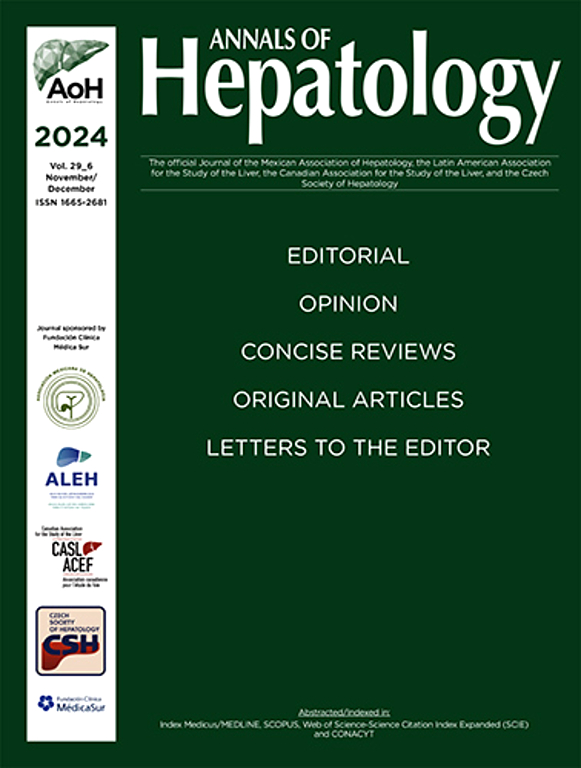High Prevalence of the FTO T allele (rs9939609 T>A) and its association with a high risk of Type 2 diabetes or metabolic-associated steatotic liver disease (MASLD) in the Mexican population
IF 3.7
3区 医学
Q2 GASTROENTEROLOGY & HEPATOLOGY
引用次数: 0
Abstract
Introduction and Objectives
The FTO rs9939609 (T>A) polymorphism has been associated with obesity and metabolic disorders, including type 2 diabetes and MASLD. This study examined the distribution of the FTO (T>A) polymorphism in Native and admixed populations and its impact on an admixed Mexican cohort's anthropometric and metabolic profiles.
Materials and Patients
In this cross-sectional study, we evaluated 684 unrelated adults from various regions of West Mexico, categorizing them into Native, Mestizo (admixed), and Mestizo-Caucasian groups based on ancestry. Genotyping for the FTO rs9939609 polymorphism was performed using an allele discrimination assay via Real-Time PCR. Given the low prevalence of the A allele among the Mestizo subjects (n=333), the biochemical and anthropometric measurements were adjusted by genotypes AA+AT vs. TT. Anthropometric measurements were assessed using body circumferences and electrical bioimpedance. Metabolic profiles were evaluated by measuring glucose, insulin, triglycerides (TG), total cholesterol (TC), high-density lipoprotein cholesterol (HDL-c), aspartate aminotransferase (AST), and alanine aminotransferase (ALT). Metabolic abnormalities were defined as follows: hypercholesterolemia (HCL) with TC ≥200 mg/dL, high LDL-c (H-LDL) with LDL-c ≥130 mg/dL, hypoalphalipoproteinemia (HALP) with HDL-c <40 mg/dL, hypertriglyceridemia (HTG) with TG ≥150 mg/dL, hyperglycemia (HGL) with fasting glucose ≥100 mg/dL, hyperinsulinemia (HINS) with insulin >9 µUI/dL, and insulin resistance (IR) with HOMA-IR ≥2.5. Principal Component Analysis (PCA) was used to visualize genetic divergence focusing on the TT genotype. Univariate and multivariate logistic regression analyses were conducted to assess the risk association between the TT genotype and metabolic abnormalities. Statistical analyses were performed using R Studio and SPSS software.
Results
The Huicholes Native population exhibited the highest T allele frequency and TT genotype frequency (94% and 89%), followed by Mestizos from Guadalajara (74% and 56%). In contrast, Mestizo-Caucasians from Cuquio had the lowest T allele frequency (28.1%) and the highest A allele frequency (32.4%) within the Mestizo-Caucasian population of Villa Purificación. Genetic distance analysis using PCA based on FTO TT genotype prevalence revealed that the Mestizo-Caucasian population formed a distinct cluster, while Native populations displayed the highest genetic divergence among groups. When analyzing the Mestizos by genotype (AA+AT vs. TT), no significant differences were found in BMI or body fat percentage. However, metabolic profiles of TT genotype carriers showed higher waist-to-height ratios (0.49±0.08 vs. 0.52±0.07, p<0.001), insulin levels (8.8±5.2 vs. 10.8±7.3 µUI/dL, p<0.041), TG (125.8±65.3 vs. 141.8±66.5 mg/dL, p<0.017), and VLDL-c (25.6±14.2 vs. 29.1±14.8 mg/dL, p<0.015). Univariate analysis indicated that the TT genotype was associated with a higher risk of HTG (OR=1.7, 95%CI:1.07-2.73, p<0.027), IR (OR=1.79, 95%CI:1.06-3.07, p<0.031), and HGL (OR=2.77, 95%CI:1.5-5.36, p<0.002) compared to AA+AT genotypes. Multivariate logistic regression further confirmed that TT genotype carriers had a higher risk of HGL compared to AA+AT genotype carriers (OR=2.50, 95%CI:1.213-5.152, p<0.013).
Conclusions
The T allele of the FTO (rs9939609 T>A) is more prevalent in Native and Mestizo populations and is associated with higher risks of IR, HTG, and HGL, all of which are linked to type 2 diabetes and MASLD. These results highlight a genetic predisposition to metabolic diseases in populations with significant Amerindian ancestry, particularly in hepatopathogenic environments.
墨西哥人群中FTO - T等位基因(rs9939609 t> A)的高患病率及其与2型糖尿病或代谢性脂肪变性肝病(MASLD)高风险的关联
FTO rs9939609 (T>;A)多态性与肥胖和代谢紊乱有关,包括2型糖尿病和MASLD。本研究考察了FTO (T>;A)多态性在本地和混合人群中的分布及其对混合墨西哥人群的人体测量学和代谢谱的影响。材料和患者在这项横断面研究中,我们评估了来自西墨西哥不同地区的684名无血缘关系的成年人,根据祖先将他们分为土著、混血儿和混血儿-高加索人群。采用实时荧光定量PCR对FTO rs9939609多态性进行基因分型。鉴于混血儿受试者(n=333)中A等位基因的低患病率,生化和人体测量测量采用AA+AT与TT基因型进行调整。人体测量测量使用体长和电生物阻抗进行评估。通过测量葡萄糖、胰岛素、甘油三酯(TG)、总胆固醇(TC)、高密度脂蛋白胆固醇(HDL-c)、天冬氨酸转氨酶(AST)和丙氨酸转氨酶(ALT)来评估代谢谱。代谢异常定义如下:高胆固醇血症(HCL), TC≥200 mg/dL,高LDL-c (H-LDL), LDL-c≥130 mg/dL,低脂蛋白血症(HALP), HDL-c≥40 mg/dL,高甘油三酯血症(HTG), TG≥150 mg/dL,高血糖症(HGL),空腹血糖≥100 mg/dL,高胰岛素血症(HINS),胰岛素≥9 μ UI/dL,胰岛素抵抗(IR), HOMA-IR≥2.5。采用主成分分析(PCA)对TT基因型的遗传差异进行可视化分析。采用单因素和多因素logistic回归分析来评估TT基因型与代谢异常之间的风险关联。采用R Studio和SPSS软件进行统计分析。结果Huicholes土著人群的T等位基因频率和TT基因型频率最高(94%和89%),其次是瓜达拉哈拉的meestizos(74%和56%)。库奎奥的混血儿T等位基因频率最低(28.1%),而维拉Purificación的混血儿A等位基因频率最高(32.4%)。基于FTO TT基因型流行率的PCA遗传距离分析表明,混血儿-高加索人群体形成了一个独特的聚类,而土著群体之间的遗传差异最大。当按基因型(AA+AT vs. TT)分析混血儿时,BMI和体脂率没有发现显著差异。然而,TT基因型携带者的代谢谱显示出更高的腰高比(0.49±0.08比0.52±0.07,p<0.001)、胰岛素水平(8.8±5.2比10.8±7.3 μ UI/dL, p<0.041)、TG(125.8±65.3比141.8±66.5 mg/dL, p<0.017)和VLDL-c(25.6±14.2比29.1±14.8 mg/dL, p<0.015)。单因素分析表明,与AA+AT基因型相比,TT基因型与HTG (OR=1.7, 95%CI:1.07-2.73, p<0.027)、IR (OR=1.79, 95%CI:1.06-3.07, p<0.031)和HGL (OR=2.77, 95%CI:1.5-5.36, p<0.002)的风险较高。多因素logistic回归进一步证实TT基因型携带者发生HGL的风险高于AA+AT基因型携带者(OR=2.50, 95%CI:1.213 ~ 5.152, p<0.013)。结论FTO的T等位基因(rs9939609 T>;A)在土著和混血儿人群中更为普遍,并且与IR、HTG和HGL的高风险相关,所有这些都与2型糖尿病和MASLD有关。这些结果突出了具有显著美洲印第安血统的人群对代谢性疾病的遗传易感性,特别是在肝病环境中。
本文章由计算机程序翻译,如有差异,请以英文原文为准。
求助全文
约1分钟内获得全文
求助全文
来源期刊

Annals of hepatology
医学-胃肠肝病学
CiteScore
7.90
自引率
2.60%
发文量
183
审稿时长
4-8 weeks
期刊介绍:
Annals of Hepatology publishes original research on the biology and diseases of the liver in both humans and experimental models. Contributions may be submitted as regular articles. The journal also publishes concise reviews of both basic and clinical topics.
 求助内容:
求助内容: 应助结果提醒方式:
应助结果提醒方式:


